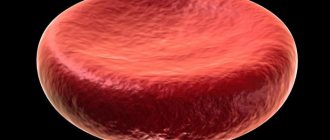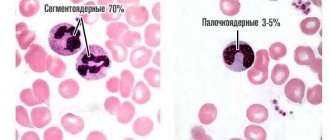During pregnancy, a woman undergoes a large number of various tests. This is done as prescribed by the gynecologist at the antenatal clinic to monitor the condition of not only the expectant mother, but also the baby. One of the most necessary studies is a general blood test for a pregnant woman. Thanks to it, many indicators are determined, including the level of red blood cells in the blood. Based on this value, the specialist will judge whether the baby is receiving enough oxygen and whether there are any pathological changes in the body of the expectant mother.
Preparing and conducting analysis
On average, a pregnant woman undergoes a clinical blood test every month. Passing it is considered standard procedure.
To do this, in the morning (before 10.00) capillary blood is taken from a finger. The results, as a rule, are ready the next day and are transferred to the gynecologist leading the pregnancy.
There are a number of preparatory activities, the implementation of which will help to obtain a more accurate result:
- The analysis is carried out on an empty stomach. The last meal is dinner, 8-10 hours before the analysis,
- On the eve of collecting biomaterial, you can only drink water,
- The intake of medications and vitamin complexes is suspended. If it is impossible to comply with this point, consult your doctor, he may change the dosage,
- Physical and emotional stress on the body is reduced to a minimum.
Treatment and prevention
To identify the cause of low red blood cells in the expectant mother’s body, the attending physician will prescribe a repeat test. The patient should know some simple rules that will allow her to obtain a reliable result.
Before the procedure for collecting material, a woman should not experience strong emotional shocks. This also applies to physical activity. A day before the appointed day, you should not experiment with unusual and harmful foods. The test takes place in the morning on an empty stomach. At least 10 hours must have passed since your last meal. In the morning you are only allowed to drink.
After completing all the procedures and establishing a diagnosis, the doctor will draw up a treatment regimen. Depending on the underlying cause of the low blood cell count, treatment may include the following:
- If the condition of a pregnant woman is caused by an unbalanced and poor-quality diet, reduced physical activity, the expectant mother will be offered recommendations regarding changes in lifestyle and nutrition. A woman should eat foods that can provide her with all the necessary vitamins and minerals. Daily walks in the fresh air are required.
- If the cause of erythropenia turns out to be an infectious disease, the doctor will prescribe a treatment regimen based on taking medications in combination with vitamin and mineral complexes.
- If the source of the pathology lies in fluid stagnation in the female body, the specialist will prescribe diuretics and indicate the need to follow a low-salt diet.
- If the pathology is caused by severe blood loss, doctors will direct their efforts to restore the condition of the pregnant woman. You may need to use medications and vitamins containing iron to promote hematopoiesis. The patient is advised to consume more fluids and create an appropriate menu.
Products with a high iron content
In cases where a decrease in the number of red blood cells in the blood is associated with serious causes, such as malignant neoplasms and anemia, treatment measures will be carried out under the supervision of medical personnel in an inpatient setting. In order to reduce the risk of future problems of this nature, you should periodically undergo tests prescribed by your doctor and try to lead a healthy lifestyle.
Diet therapy as the basis of a pregnant woman’s lifestyle
Any woman during pregnancy should be aware of the importance of the process. As soon as it becomes known that a new family member is expected to be added in the future, you need to contact a medical institution to register for pregnancy and childbirth. Constant monitoring by an experienced doctor and compliance with his instructions is the main condition for maintaining the health of the expectant mother and her baby.
Increased level
A high level of red blood cells in the blood should be expected if:
- Emotional shock was suffered
- Regular physical activity is carried out,
- Residence is located in the mountains,
- Heat.
An increase in the concentration of red cells as a result of toxicosis and dehydration is not considered a pathology, since it is associated with functional changes, and the volume of blood plasma decreases. Therefore, such erythrocytosis is considered a relative value and cannot be taken into account.
If the red blood cells in the results form are elevated, this may be a symptom of the development of diseases:
- Of cardio-vascular system,
- Kidney failure
- Liver dysfunction,
- diseases of the respiratory system.
Many people mistakenly believe that an increased level of red blood cells during pregnancy will provide the baby with more oxygen. Everything is completely wrong. With such indicators, the blood becomes thicker, which means its transport ability slows down. As a result, only remnants of oxygen will reach the baby, most of which will be processed and oxidized along the way. All this can develop fetal hypoxia.
Red blood cells in the blood during pregnancy: what is this indicator
Red blood cells are produced in the red bone marrow.
They are utilized in the spleen. During development, they form hemoglobin, which contains protein and iron. This structure is necessary for the cell to absorb oxygen and carbon dioxide. The first substance is transferred from the alveoli of the lungs to the organs. From there, red blood cells collect carbon dioxide, which is transported back to the pulmonary system. For healthy people without gestation, the indicator should be in the range of 3.5-5.5 × 1012 cells/l.
There are two types of indicator changes:
- erythropenia – decreased number of red cells;
- erythrocytosis - increased value.
There are physiological and pathological causes of the disorder. In the first case, treatment is not required; the factors that caused the changes should be eliminated. In the second case, the indicator will return to normal when therapeutic measures are carried out.
Red blood cells are determined using a general clinical blood test. It can be done in two ways.
- Microscoping. The doctor places a stained sample of human biological fluid under a microscope, and the cells in the field of view are determined. To do this, the microscope is moved from left to right, down, right to left. That is, they count the cells manually. The disadvantage of the method is the lack of calculation of the value in the entire volume of biological fluid. It is determined only in 1 ml. The positive side is the determination of the shape, structure, and quality of cells. Other disorders may be detected, the appearance of substances that should not normally be present.
- Application of a semi-automatic hematology analyzer. After collecting the biomaterial, the doctor adds an anticoagulant, which prevents the biological fluid from coagulating and forming a clot. The device takes liquid from the test tube. The analyzer automatically calculates the parameters and issues a research form. The analysis eliminates the medical error factor, but does not determine every other parameter.
Learn more about red blood cell counting methods and possible errors.
To minimize the risk of errors in the process of microscopy and the use of semi-automatic analyzers, two methods are carried out at once. This is how the most reliable results are revealed.
After receiving the results form, the patient must take them to the attending physician. It is impossible to independently determine the reason for a change in any indicator. The doctor may order other diagnostic tests if abnormal.
Important! To determine the most reliable values, two tests are prescribed. If the data is identical, the information is true.
Indications for testing for red blood cells during pregnancy
During gestation, a woman undergoes laboratory tests every 2 weeks. This allows the doctor to identify health abnormalities at an early stage. The sooner treatment begins, the lower the risk of complications for the woman and the fetus.
There are the following indications for taking the test:
- prevention for timely detection of deviations from the norm;
- detection of anemia in previous tests;
- detection of erythrocytosis in previous tests (increased number of red cells);
- low or high levels of iron in the blood;
- low or high hemoglobin levels;
- diabetes;
- the presence of an increased number of red blood cells in the urine;
- the presence of a malignant blood disease;
- identified area of minor or significant bleeding;
- determining the quality of treatment;
- chronic diseases that can lead to bleeding.
If the results indicate a decrease or increase in the indicator, the doctor will prescribe additional diagnostic tests that will help identify the cause.
Reduced level
During pregnancy, as a rule, the level of red blood cells becomes lower than usual. But you should carefully ensure that it is within the lower limit of the standards.
The content of red blood cells in the blood is pathologically reduced (erythropenia) in the following cases:
- Incorrectly selected diet
- Significant blood loss
- disturbances in the functioning of internal organs - kidneys, heart or liver,
- Anemia,
- Deficiency of iron, vitamin B, folate,
- Chronic inflammatory process,
- Infectious diseases,
- Autoimmune diseases,
- Frequent pregnancies - the interval between them is less than 3 years,
- frequent and uncontrolled use of antibiotics,
- Hormonal disorders
- Leukemia and other blood tumors,
- Hemolysis is the “dissolution” of red blood cells and disruption of the integrity of their membrane.
In case of erythropenia, a pregnant woman experiences the following symptoms:
- Pallor of the skin,
- Low blood pressure,
- Cardiopalmus,
- Drowsiness,
- Constant fatigue
- Cold wet palms
- Fainting is possible.
A low level of red blood cells in the first trimester is not considered a pathology, so no urgent measures need be taken. But if anemia develops, caused precisely by a drop in the level of red blood cells, then it is necessary to treat immediately, otherwise there is a high risk of conditions such as:
- Premature birth
- Hemorrhages,
- Weak labor activity
- Fetal underdevelopment
Attention! It is commonly believed that anemia is a decrease in hemoglobin levels, but since hemoglobin is contained in red blood cells, a decrease in the concentration of red blood cells most often leads to anemia.
The main reasons for the decrease in the number of red blood cells
Frequent ARVI and taking antibiotics are the cause of erythropenia
In addition to physiological or “false” anemia, there are a number of other reasons why the number of blood cells may become smaller. The term “erythropenia” is used to refer to the lack of red blood cells in human blood. The main reasons for its occurrence in pregnant women include:
- iron deficiency in the mother’s body (iron atoms are part of hemoglobin and are directly involved in the transport of oxygen);
- infectious diseases;
- disruptions in the functioning of the endocrine system;
- decreased immunity due to chronic maternal diseases;
- antibacterial therapy;
- renal failure;
- significant blood loss (the body launches compensatory mechanisms, trying to replenish blood volumes, and the concentration of red blood cells is restored much more slowly);
- cancer (including leukemia - blood cancer);
- general exhaustion of the body caused by stress or recent childbirth;
The expectant mother should remember that the best prevention of erythropenia is a planned pregnancy, which was preceded by the necessary preparations: health monitoring, courses of vitamins, etc. If symptoms of erythropenia appear, it is important to begin treatment as quickly as possible in order to protect yourself and the child from unpleasant consequences.
Principles of treatment
When the condition “low red blood cell count” is confirmed, it is important to identify and eliminate the cause.
The following methods are used for this:
- Making changes to the menu of the expectant mother. Foods rich in folic acid, iron, and copper are introduced into the diet. It is recommended to drink juices and herbal infusions,
- Alcohol, tobacco and drugs are strictly prohibited,
- Vitamin complexes for pregnant women are prescribed,
- If stagnation of fluid in the body is detected, then diuretics are prescribed and a salt-free diet is prescribed,
- For infectious lesions, special immunostimulants are prescribed in combination with therapeutic measures.
Red blood cells in the blood during pregnancy: the norm by trimester in the table
The indicator is detected in a general clinical study. If the value changes slightly, within 10 units, this is considered a variant of the norm. There is no cure for this condition. Over time, the indicator will return to normal if the patient is healthy.
There are options for the normal indicator during gestation.
| Gestational age | Norm of red blood cells, million/μl |
| First trimester | 4,3-5,4 |
| Second trimester | 3,6-4,9 |
| Third trimester | 3,8-5,1 |
In the first trimester, the lower limit of normal is higher than in patients with absence of a fetus. This is due to the fact that the hormonal background changes, all forces are activated to create favorable conditions for the embryo.
In the second and third trimester, the indicator may be slightly reduced, as an additional circulation is formed due to the formation of the placenta. A large volume of hemoglobin and red blood cells goes into this area, since the embryo requires a large amount of nutrients and air oxygen for normal growth.
Reduced red blood cells during pregnancy
A decrease in red blood cells in the blood during pregnancy is accompanied by clinical symptoms, which will lead the doctor to suspect the condition:
- malaise (weakness, fatigue, lethargy, drowsiness);
- cardiopalmus;
- dampness of palms;
- cool extremities;
- decreased blood pressure;
- pale, sickly appearance;
- darkening before the eyes;
- Rarely fainting.
There are many physiological and pathological reasons that lead to a decrease in red blood cells during pregnancy in the 3rd trimester or early stages:
- reduced intake of nutrients, microelements, minerals, vitamins, amino acids from food;
- lack of use of multivitamins, which are always necessary for normal pregnancy;
- minor chronic blood loss;
- heavy blood loss;
- disease of the cardiovascular system, urinary and digestive tract;
- anemia;
- introduction of an infectious agent into various organs;
- constant stress, nervous breakdowns, fatigue;
- malignant neoplasms that have metastasized;
- hormonal imbalance;
- exhaustion of the body due to a short break between fertilization;
- antibiotic use
Low red blood cells in the blood during pregnancy lead to complications for the expectant mother and fetus, and treatment is required.
Reduced hemoglobin and red blood cells during pregnancy
Hemoglobin and red blood cells in the blood below normal during pregnancy are formed for the following reasons:
- decreased intake of nutrients, microelements, minerals, vitamins through food;
- the formation of hypercalcemia (increased calcium levels), which interferes with the absorption of iron;
- presence of slight or heavy bleeding;
- diseases of the digestive tract that lead to a reduced supply of nutrients to the blood;
- toxicosis in the early and late stages, due to which the patient becomes exhausted;
- the presence of more than one fetus in a woman’s uterus, which leads to an abundant supply of hemoglobin to the placenta.
If both values are below normal, this interferes with the normal blood supply to the placenta, and fetal hypoxia develops. This condition is fraught with impaired growth and formation of its internal organs.
Reduced red blood cells and hematocrit during pregnancy
Hematocrit is a value that indicates the total number of red cells in the entire blood. The study to determine it is carried out separately; it is not included in general clinical testing. The state of decreased red blood cells during pregnancy in the 2nd trimester and later is formed due to the following factors:
- disruption of the kidneys, as a result of which a large number of cells are released through them (glomerulonephritis, pyelonephritis, hydronephrosis, malignant neoplasm);
- liver and gastrointestinal diseases;
- introduction of an infectious agent;
- reduced intake of nutrients, microelements, minerals, vitamins, lack of use of multivitamins.
If the value is significantly reduced, urgent therapy is required.
Elevated red blood cells in the blood during pregnancy
An increase in value does not indicate that the woman and fetus will receive more oxygen. This means that the blood thickens and therefore circulates more slowly. This also leads to hypoxia.
The causes of erythrocytosis are the following conditions and diseases:
- dehydration of the body, which leads to a decrease in plasma concentration and an increase in formed elements (thickening is formed, circulation slows down);
- cardiovascular diseases;
- malignant neoplasms;
- severe toxicosis leading to dehydration;
- infectious diseases accompanied by vomiting.
During gestation, it is important to determine the number of red blood cells. They can be within normal limits, increased or decreased. If the value changes slightly, this refers to physiological disturbances, which are subsequently restored. If the value changes by more than 10 units, the doctor must identify the cause in order to prevent the development of complications.
Learn more about a general blood test during pregnancy and its interpretation.
Ekaterina Belikova, laboratory diagnostics doctor, especially for Mirmam.pro
Signs and symptoms
A significant deviation from the norm in red blood cell counts is a sign of anemia. The lower the level, the more severe the degree of anemia. Therefore, pregnant women should not ignore the signs of emerging anemia. Symptoms are expressed:
- weakness;
- dizziness;
- tachycardia;
- increased sweating;
- drowsiness;
- pale skin;
- lethargy;
- headache;
- decreased concentration;
- emotional stress;
- irritability.
Mostly, pregnant women develop iron deficiency anemia, which manifests itself by external signs and disruption of the functioning of internal organs. Among women:
- hair becomes brittle;
- nails peel and break;
- skin pale and dry;
- there are microcracks, peeling on the skin;
- stomatitis appears;
- mucous membranes become inflamed;
- general immunity decreases;
- liver function is impaired.
Helpful advice! If these symptoms appear, you should contact your gynecologist. Anemia is a dangerous disease that causes a number of complications.
Signs of anemia
Prevention
The day a woman learns about her interesting situation, she must understand that from that moment she is also responsible for the health of her unborn baby. Therefore, in no case should you refuse to take tests that are regularly prescribed by a specialist. It is also equally important to do everything possible to protect yourself as much as possible from a decrease in the number of red blood cells in the blood. The following will help in this matter:
- a balanced diet, which includes eating foods rich in iron, folic acid, copper and other beneficial substances;
- giving up alcohol, smoking and other bad habits;
- moderate physical activity;
- timely diagnosis and treatment of various diseases.
Finally, it is worth reminding once again that expectant mothers during pregnancy should treat their health with special care, promptly seek help from a doctor and take all tests prescribed for them on time.
Normal limits
A general blood test in pregnant women should show approximately the following results:
- In the first trimester (*1012 / l) - 3.5-5.4;
- In the second trimester (*1012 / l) – 3.2-4.8;
- In the third trimester (*1012 / l) – 3.5-5.0.
By the way, in non-pregnant women the norm of red blood cells in the blood is in the range (*1012 / l) 3.9-4.7.
Danger and consequences
Low red blood cells in the first trimester of pregnancy are not a pathology and do not need adjustment, since in order to avoid disruption of blood circulation during this period, it must be diluted. But if anemia occurs due to a drop in the number of red blood cells, appropriate treatment is needed, otherwise the following serious complications may occur :
- Disturbances in fetal development.
- Premature birth.
- Significant external hemorrhages.
- Weak labor.
- Death of a newborn on the first day.
Red blood cells and their role
Red blood cells are small blood cells containing hemoglobin. Their main role is to transport oxygen from the lungs to all tissues and organs and remove carbon dioxide on the way back. Red blood cells help the body produce antibodies to different types of viruses. These blood cells find the source of the disease, linking the “poisoners” together. When your red blood cell count is low, it can signal problems. In this case, the gynecologist may prescribe an additional test to determine the level of red blood cells in the blood and urine of a pregnant woman.











